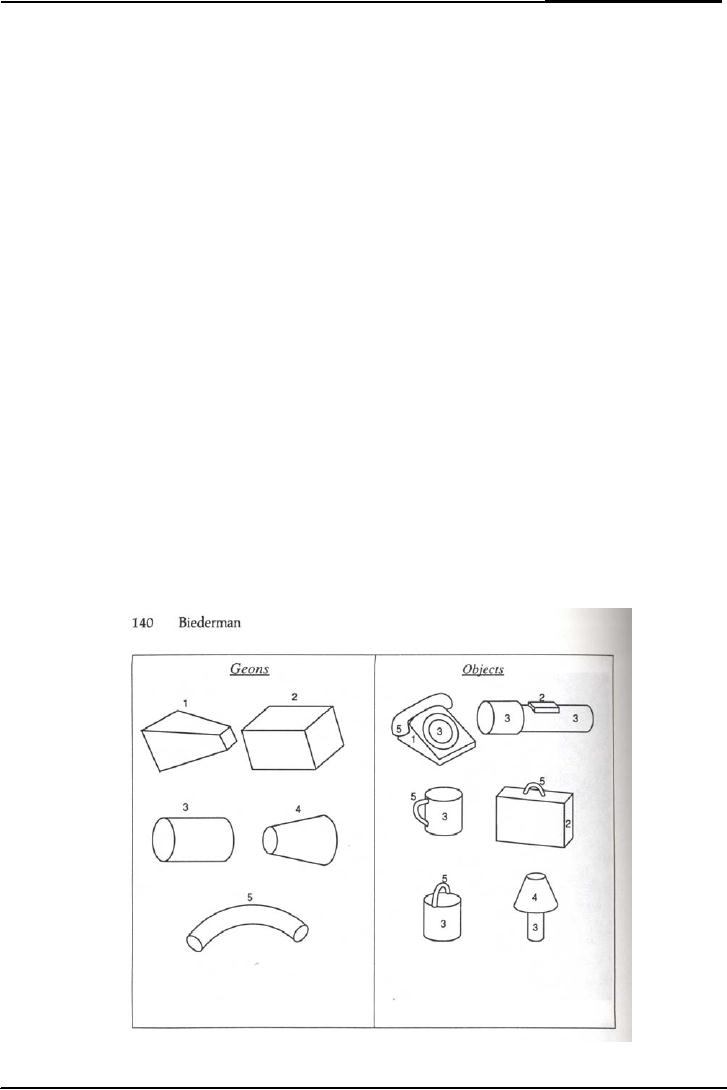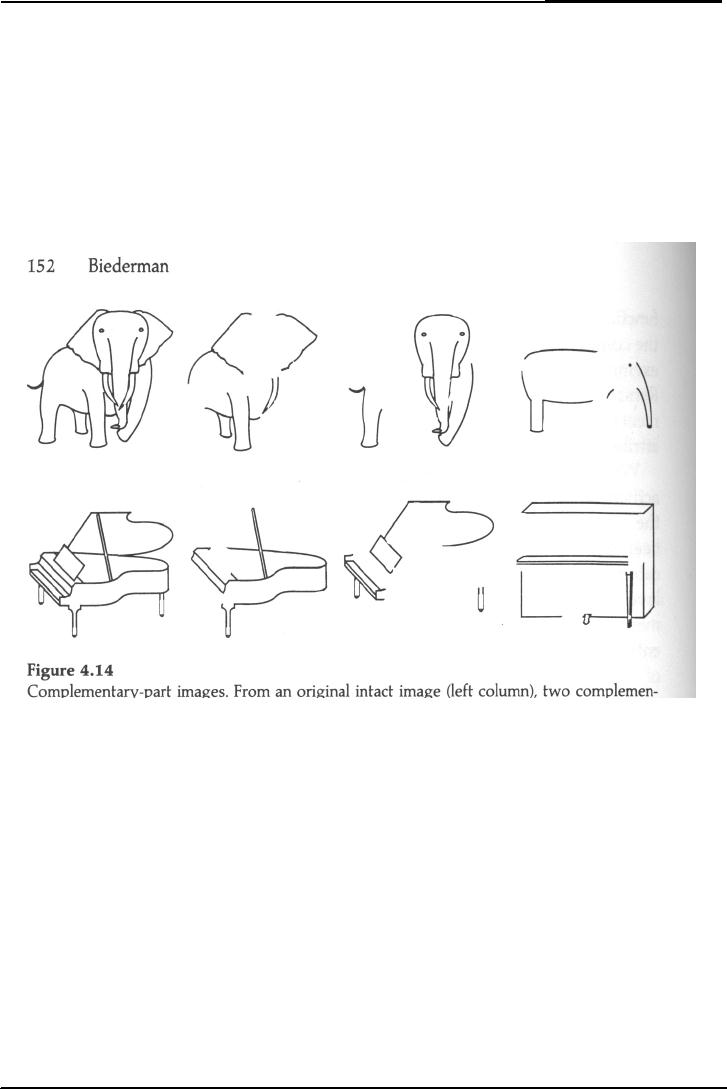 |
OBJECT PERCEPTION (continued):Segmentation, Recognition of object |
| << PATTERN RECOGNITION (continued):Queen Elizabeth’s vase, Palmer (1977) |
| ATTENTION & PATTERN RECOGNITION:Word Superiority Effect >> |

Cognitive
Psychology PSY 504
VU
Lesson
19
OBJECT
PERCEPTION (continued)
Biederman
(1987) proposed three stages
in recognition of an object as a
configuration of simpler
components
Segmentation
into sub-objects
Classify
the category of each
sub-object
Recognition
as a pattern made of
sub-objects
1.
Segmentation
Sub-objects
are defined by their line
contours Edge and bar
detectors from David
Marr.
Hoffman
and Richards (1985)
Gestalt principles can be
used to segment an
outline
representation
of an object into sub-objects.
They observe that where
one segment joins
another
there
is typically a concavity in the
line outline.
2.
Classification of sub-object
categories
Second,
once an object has been
segmented into basic
sub-objects, one can
classify the
category
of each sub-object. Biederman
(1987) argues that there
are 36 basic categories of
sub-
objects,
which he calls Geons which
is abbreviation of geometric
ions.
The
five geons are showed in
following figure. There are
geons that are making
different objects.
Like
number 1 geon is a part of
telephone. And geon number 5 is a
receiver of telephone set.
He
uses
geons to explain the
objects. He says we can vary
the size of the shape
and get different
objects.
Same type of geons makes
different things of different
organization. Altogether
Biederman
proposes there are 36 geons
that can be generated in
this manner and that
they
serve
as an alphabet for composing
objects, much as letters or
phonemes serve as the
alphabet
for
building up words.
60

Cognitive
Psychology PSY 504
VU
3.
Recognition of object
Third,
having identified the pieces
out of which the object is
composed and their
configuration,
one
recognizes the object as the
pattern composed from these
sub-objects or pieces.
Thus,
recognizing
an object is like recognizing a
letter; the sub-objects
become the features.
Minor
details and variations don't
matter. As in the case of
letter recognition there are
many small
variations
on the underlying features
geons that should not be
critical for recognition.
Edges are
more
important than texture to
define geons. Color,
texture, and small detail
should not matter.
This
predicts that schematic line
drawings of complex objects
which allow the basic
geons to be
identified
should be recognized as quickly as
detailed color photographs of
the objects.
Biederman
conducted an experiment to test
his hypothesis. He showed
different shapes to
subjects.
They created two
conditions.
Segment
deletion
Component
deletion
In
that experiment some objects
had whole components deleted
while others had all
the
components
present but segments of
these components were
deleted. They presented
these two
types
of degraded figures to subjects
for various brief intervals
and asked them to identify
the
objects.
Like
in above figures, the
components of elephants are
separated and showed. In one
figure the
components
were deleted.
Biederman's
evidence
The
critical assumption is that
object recognition is mediated by
recognition of the components
of
the
object. The results showed,
at very brief presentations
(65-100 milliseconds) subjects
were
61

Cognitive
Psychology PSY 504
VU
more
accurate at the recognition of
figures with component
deletion than segment
deletion. This
reversed
for the longer 200
milliseconds presentations. Biederman
reasoned that at the
very
brief
intervals subjects were not
able to identify the
components with segment
deletion and so
had
difficulty in recognizing the
objects. With 200
milliseconds exposure, however,
sub-objects
were
able to recognize all the
components in either condition.
Since there were more
components
in
the condition with segment
deletion they had more
information as to object
identity.
So,
we can conclude it that we do
not split reality in geon or
anything else. We bring all
the
information
into our sensory store.
There is difference between
reality and
representativeness,
reality
and perception, and reality
and recognition.
62
Table of Contents:
- INTRODUCTION:Historical Background
- THE INFORMATION PROCESSING APPROACH
- COGNITIVE NEUROPSYCHOLOGY:Brains of Dead People, The Neuron
- COGNITIVE NEUROPSYCHOLOGY (CONTINUED):The Eye, The visual pathway
- COGNITIVE PSYCHOLOGY (CONTINUED):Hubel & Wiesel, Sensory Memory
- VISUAL SENSORY MEMORY EXPERIMENTS (CONTINUED):Psychological Time
- ATTENTION:Single-mindedness, In Shadowing Paradigm, Attention and meaning
- ATTENTION (continued):Implications, Treisman’s Model, Norman’s Model
- ATTENTION (continued):Capacity Models, Arousal, Multimode Theory
- ATTENTION:Subsidiary Task, Capacity Theory, Reaction Time & Accuracy, Implications
- RECAP OF LAST LESSONS:AUTOMATICITY, Automatic Processing
- AUTOMATICITY (continued):Experiment, Implications, Task interference
- AUTOMATICITY (continued):Predicting flight performance, Thought suppression
- PATTERN RECOGNITION:Template Matching Models, Human flexibility
- PATTERN RECOGNITION:Implications, Phonemes, Voicing, Place of articulation
- PATTERN RECOGNITION (continued):Adaptation paradigm
- PATTERN RECOGNITION (continued):Gestalt Theory of Perception
- PATTERN RECOGNITION (continued):Queen Elizabeth’s vase, Palmer (1977)
- OBJECT PERCEPTION (continued):Segmentation, Recognition of object
- ATTENTION & PATTERN RECOGNITION:Word Superiority Effect
- PATTERN RECOGNITION (CONTINUED):Neural Networks, Patterns of connections
- PATTERN RECOGNITION (CONTINUED):Effects of Sentence Context
- MEMORY:Short Term Working Memory, Atkinson & Shiffrin Model
- MEMORY:Rate of forgetting, Size of memory set
- Memory:Activation in a network, Magic number 7, Chunking
- Memory:Chunking, Individual differences in chunking
- MEMORY:THE NATURE OF FORGETTING, Release from PI, Central Executive
- Memory:Atkinson & Shiffrin Model, Long Term Memory, Different kinds of LTM
- Memory:Spread of Activation, Associative Priming, Implications, More Priming
- Memory:Interference, The Critical Assumption, Limited capacity
- Memory:Interference, Historical Memories, Recall versus Recognition
- Memory:Are forgotten memories lost forever?
- Memory:Recognition of lost memories, Representation of knowledge
- Memory:Benefits of Categorization, Levels of Categories
- Memory:Prototype, Rosch and Colleagues, Experiments of Stephen Read
- Memory:Schema Theory, A European Solution, Generalization hierarchies
- Memory:Superset Schemas, Part hierarchy, Slots Have More Schemas
- MEMORY:Representation of knowledge (continued), Memory for stories
- Memory:Representation of knowledge, PQ4R Method, Elaboration
- Memory:Study Methods, Analyze Story Structure, Use Multiple Modalities
- Memory:Mental Imagery, More evidence, Kosslyn yet again, Image Comparison
- Mental Imagery:Eidetic Imagery, Eidetic Psychotherapy, Hot and cold imagery
- Language and thought:Productivity & Regularity, Linguistic Intuition
- Cognitive development:Assimilation, Accommodation, Stage Theory
- Cognitive Development:Gender Identity, Learning Mathematics, Sensory Memory